Once a rare species in private collections, they have come a long way, and now are available for anyone who has the desire to own these beautiful amphibians.
Like any other animal, Dart Frogs have special requirements to remain healthy. If you provide what they need, and have the time to properly care for them, they will provide you with many hours of enjoyment. Once you have a little experience, you may even want to give breeding them a try.
I can remember many years ago, when our local zoo bred some dart frogs, and at the time it was considered quite an accomplishment. Today however, it is considered commonplace for them to be bred in private collections.

Dart Frogs in Captivity
by pawpaw
Dart Frogs are some of the most colorful, and interesting animals on the planet. Here you will find information on how to keep dart frogs in captivity, and where to buy them.
Which Dart Frog Species Make Good Pets
There are many species of Dart Frogs, and some are more hardy than others. If you are interested in keeping Dart Frogs, then you should start with one of the more hardy species.
Some of the more commonly kept species include, Dendrobates aurates, Dendrobates leucomelas, Dendrobates tinctorius. There are more, but these are a good place to start looking.
Once you have decided which species you would like to keep, the next decision is to decide which morph you would like. What is a morph? Well, there is a very large variability in appearance, in some dart frog species. They come in many colors, and patterns. Most morphs have their own names. Some morph names describe the appearance of the morph, and some names are related to their locality in the wild.
Phyllobates terribilis
 Phyllobates terribilis, the Golden Po... | 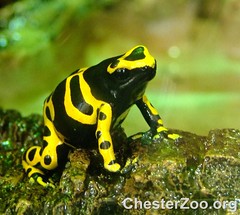 Golden poison dart frog, Phyllobates... |
Dendrobates auratus
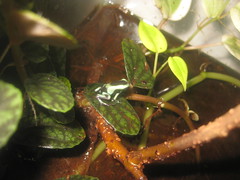 Baby auratus | 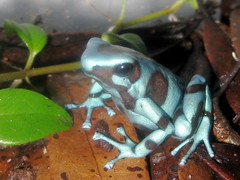 D. auratus |
Dendrobates leucomelas
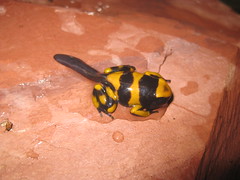 Leuc tad, just about out of the water | 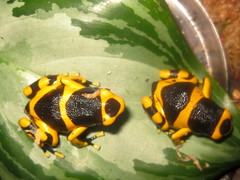 D. leucomelas |
This photo of a group of Oophaga pumilio (sometimes referred to as Dendrobates Pumilio), shows just how much variability there is within one species. Many people call this species Strawberry Poison Dart Frog.
Stawberry Poison Dart Frogs, are part of a group of Dart Frogs, call egg feeders. They are very interesting, because unlike many amphibians, that just lay their eggs, and go off to let them fend for themselves, egg feeders actually take care of their babies. Once the eggs are laid (usually on a leaf), and fertilized, the female returns and lays unfertilized eggs for the tadpoles to eat. She does this for weeks, until they turn into little frogs. The male also has a job to do. He keeps the eggs moist, and takes water to them when needed, and stays around to defend the nest.
About a week and a half after the eggs are laid, the female moves the tadpoles to a place with standing water. She does this by letting the tadpoles wiggle up on her back.
Educate Yourself
Learn Everything You Can About The Frog You Would Like to Have
As you can see from the photos above, there are many different colors and patterns to choose from. I will try to include more photos, but once you have decided on a species and morph, the next thing to do, is educate yourself on that species, and what you will need to keep them happy and healthy.
Most Dart Frogs are pretty similar in requirements, but their can be some differences, so education is important, before you invest in a terrarium, and plants to populate it. You can learn a lot on the internet, and I will provide a few links to some sited that have detailed information on keeping and breeding dart frogs, but in my opinion, any person who wants to keep any animal in captivity, should buy a good book about that animal, and learn as much as they can before making a purchase.
As well as learning about your frog, you will have the book as a handy reference, in case you need it. Having kept reptiles and amphibians all my life, I think have a reference book is one of the smartest things you can do before starting with any new species.
I've provided a few books here to choose from. I would recommend looking at several, and reading the reviews, before making a purchase. Get the best one you can afford.
 | Poison Dart Frogs: A Complete Guide to Dendrobatidae (Complete Herp Care) Poison dart frogs are known by many for their bright colors and poisonous skins. This expert guide covers all of the common species as well as a number of rarer ones, and is the... |
 | Poison Dart Frogs: A Guide to Care and Breeding Poison Dart Frogs is a complete manual to the care and breeding of poison dart frogs. This guide provides step-by-step instructions on building a terrarium and culturing fruit f... |
 | Poison Frogs: Biology, Species & Captive Husbandry Provides practical information on keeping and breeding, most common diseases and their treatment, and important information on all aspects of captive husbandry of the known spec... |
 | Poison Dart Frogs (Reptile and Amphibian Keeper's Guides) These spectacularly colored frogs are native to Neotropical rain forests in many parts of the world. They lose their toxicity when kept in captivity. Titles in the growing Repti... |
What Should You Know, Before Buying a Frog?
You should know everything there is to know about the frog you would like to keep.
Things like, what they eat, what kind of temperature range they need to be healthy, many books also have helpful photos, that sometimes will make things clearer than text alone. Further down the page, I will provide links to various Dart Frog Care Sheets, than will give basic information on keep Dart Frogs, but if you are serious about keeping them, you should learn more than just the basics.
What do Poison Dart Frogs Eat?
In the wild, Poison Dart Frogs eat a variety of small insects. Beetles, flies, mosquitoes, and other tiny flying and crawling insects. Wild Poison Dart Frogs, are actually poison, and they get their poison from their diets. In captivity, they don't get the same diet, and therefore captive bred Dart Frogs are not poison.
In captivity, most keepers feed primarily flightless fruit flies. They can also eat small crickets, but trying to find a consistent source for small crickets is pretty hard to do. Crickets small enough for them to eat, would have to be newly hatched.
Flightless Fruit Flies can be easily cultured, and the supplies to get started are pretty easy to acquire, so for that reason, I would suggest going with Flightless Fruit Flies as a main food source for your frogs.
The video below will give you an idea of just how small their food items are.
Dart Frogs Eating
Flightless Fruit Fly Starter Kit
Everything you need to get started.
This Flightless Fruit Fly Starter Kit, comes with everything you will need to get started raising your own Flightless Fruit Flies to feed your frogs. With what is provided, you basically add water.
It comes with full instructions, a container of fruit flies, container of fruit fly food, 2 balls that provide a surface for the flies, and two jars, which have drilled and screened lids.
Special Dietary Requirements
There is no way to match the diet that Dart Frogs have in the wild. In captivity, it is necessary to feed mostly one or two food items, in most cases. For that reason it is important to provide what your frog is missing in it's diet.
If not provided with a calcium supplement, Dart Frogs can develop a serious calcium deficiency, which can cause very serious health problems. They also require a vitamin supplement.
When supplements are in powder form, food items can be dusted with the supplements before feeding. Listed below, are a calcium supplement, and a vitamin supplement.
 | Rep-Cal Reptile Calcium Powder with D3 Rep-Cal Reptile Calcium Powder with D3Rep-Cal is an excellent source of calcium for all reptiles and amphibians. Scientifically formulated from 100% natural Oyster Shell phospho... |
 | Rep-Cal Herptivite Supplement 3.2oz Rep-Cal's HERPTIVITE is a superior multi-vitamin, multimineral and amino acid food supplement developed from the latest findings in reptile and amphibian nutritional research. I... |
Terrariums and Vivariums
Poison Dart Frogs, come from the tropical rain forests. That means they live in a very warm, very high humidity environment, with lots of plants.
Most people who keep them, like to try to get as close as they can to duplicating what the frogs would life like in the wild. One was to do that, is with a Terrarium, or Vivarium.
You will need to build a home for your frog, and there are certain things you will need. I will list some of them below.
False Bottom For Your Poison Dart Frog Vivarium
When adding things to your terrarium, you should start from the bottom up. Most people who keep Dart Frogs, add a false bottom to their vivariums.
Your frog will need a very high humidity, and for that reason, there will always be moisture in whatever container you choose for them. A false bottom give excess water a place to go, so it won't cause your substrate to be too moist, and start smelling.
Another advantage to having a false bottom, is it allows you to change water, without removing substrate, and will improve growing conditions for your plants.
Many serious keepers are now going with LECA clay balls, below their substrate, instead of gravel.
 | Hydroton GMHT10L Hydroponic Grow Rocks, 10 Liter Bag Hydroton grow rocks are a special kiln-fired, lightweight aggregate that is super-heated and formed into pebbles 8-16 mm in size. The ceramic shell and inner pore structure reta... |
 | Zoo Med HydroBalls Lightweight Expanded Clay Terrarium Substrate, 2.5 Pounds HydroBalls™ Expanded Clay Terrarium Substrate can be used as a base layer underneath Zoo Meds Eco Earth® coconut fiber substrate or other substrates to create an underground wat... |
Backgrounds
Before doing anything to your terrarium/vivarium, you should decide if want a background. If you plan to add a background to your terrarium, then you should probably put it on first, because you will need to anchor it to the glass, and would be easier to apply it first rather than later.
There are several way to create a background. I will include a video below, and it will explain several ways to do a background. One way, is with natural cork panels. You may need to do a little measuring to get pieces that will more closely match the size of enclosure you plan to use. Here are a couple of examples of cork bark panels.
 | Zoo Med Natural Cork Tile Background, 18 x 24-Inch Natural Forest Tile panels for terrarium/vivarium backgrounds. Panels are pre-cut to fit Zoo Meds Naturalistic Terrariums or can be cut for custom sizes. Perfect for high-humidi... |
 | Zoo Med Natural Cork Tile Background, 12 x 18-Inches Natural Forest Tile panels for terrarium/vivarium backgrounds. Panels are pre-cut to fit Zoo Meds Naturalistic Terrariums or can be cut for custom sizes. Perfect for high-humidi... |
 | Zoo Med Natural Cork Tile Background, 12 x 12-Inches Natural Forest Tile panels for terrarium/vivarium backgrounds. Panels are pre-cut to fit Zoo Meds Naturalistic Terrariums or can be cut for custom sizes. Perfect for high-humidi... |
Setting Up a Dart Frog Terrarium
Window Screen Between The False Bottom, and Substate
After your layer of LECA, you should place window screen (fiberglass), between the LECA, and the substrate. The screen will keep the substrate from falling down between the LECA false bottom.
 | Phifer Wire 3003951 Fiberglass Screen, Charcoal, 24-Inch by 84-Inch These charcoal fiberglass screening is woven from permanent glass yarn, which has been coated with a protective vinyl to ensure lasting beauty, color and flexibility. It is prod... |
Poison Dart Frog Substrate
When it comes to substrate, if you asked 10 people who keep dart frogs what is best to use, you might get 10 different answers. Many people have their "own" recipe.
You should probably stay away from plain potting soil, because it can get waterlogged, and too tightly packed for good plant growth, in time.
There are many types of premixed substrate mixtures on the market, or you could try to mix your own. Many dart frog keepers are going with what is called ABG mix, which is approximately: 2 parts fine tree fern fiber, 1 part milled peat, 1 part milled sphagnum moss, and 1 part fine charcoal. Many keepers will have their own slight variations of this recipe, but that comes with time, and trial and error. This combination is a good place to start.
Plants For Your Dart Frog Vivarium
Plants are what makes a Vivarium look like the Dart Frogs native habitat. There are many types of plants that can be used in a vivarium.
Before you begin to plant, it is important to come up with some sort of a plan for your plants. Plants aren't like furniture, that can be move about willy nilly. Once you decide where to plant your plant, it needs to stay there for a while.
Some plants are low growing, and some taller, so it makes sense not to have the low growing ones, hidden by the taller ones. Also, some plants need to be planted directly on wood.
Many Dart Frog Care Books have sections on plants, and you should be able to learn enough to get by from those. If you don't know a lot about plants already, you will need to do some homework before selecting your plants.
Some plants that can be uses, include Jewel Orchids, Ficus Vines, Wandering Jew, and some mosses, such as mosses that form a dense carpet in high humidity.
Vivarium Plants
Poison Dart Frog Breeders
Even though this page is a work in progess, if you have decided to get a Poison Dart Frog, here are some places you can find them.
Brian's Tropicals
They sell Dart Frogs, as well as tropical fish. Nice photo gallery too, along with articles on caring for, and breeding Poison Dart Frogs.
HERPETOLOGIC
They sell Poison Dart Frogs, and Green Tree Pythons.
Understory Enterprises Inc.
Huge selection of Poison Dart Frogs, and other amphibians and plants.
More Dendrobates Eggs on Leaves
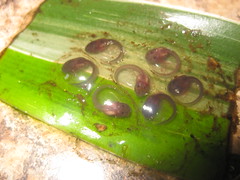 D. leucomelas eggs | 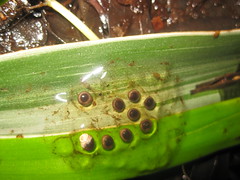 Freshly layed D. leucomelas eggs |
Eggs Ready to Hatch
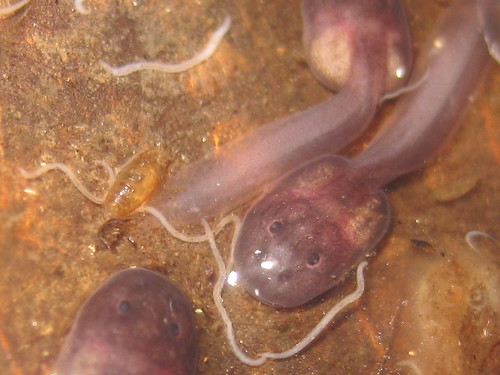 D. leucomelas eggs, ready to hatch |
Very Young Tadpole
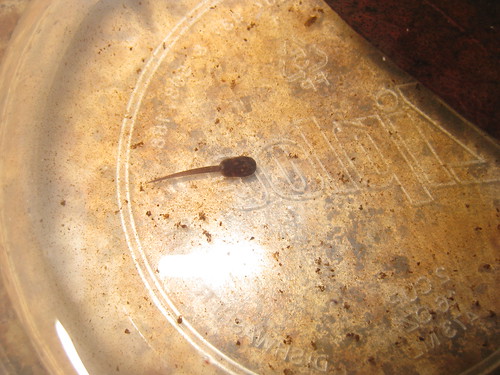 D. leucomelas young tadpole |
Dart Frog Tadpole With Hind Legs
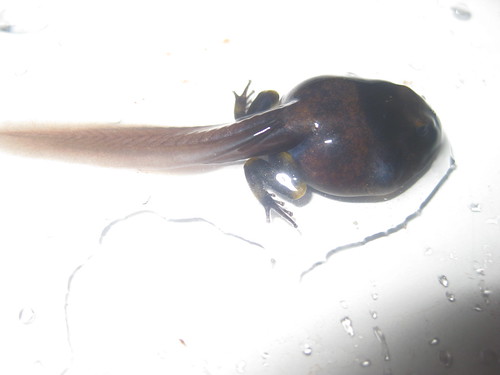 D. leucomelas tadpole, hind legs developed 09.05.23 |
Almost a Frog
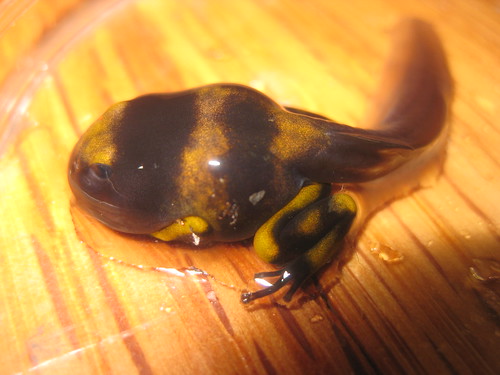 D. leucomelas tadpole, almost fully morphed 09.05.28 |
You might also like
Snakes For Sale OnlineWhere can you buy snakes for sale online? The short answer is, lots of places...
Amazing Photos of Albino, Leucistic, Piebald, and other Animal...Whenever animals don't look the way they are supposed to look, it is very int...
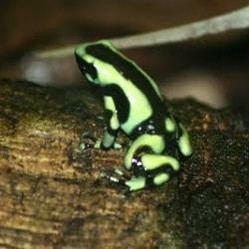

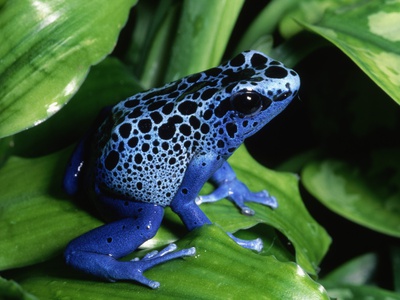
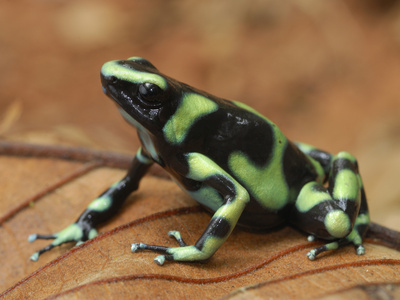
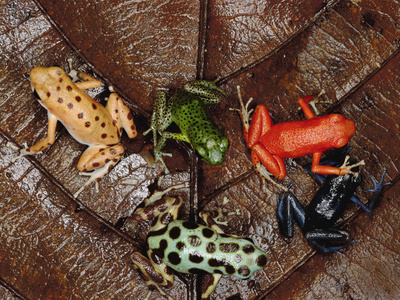

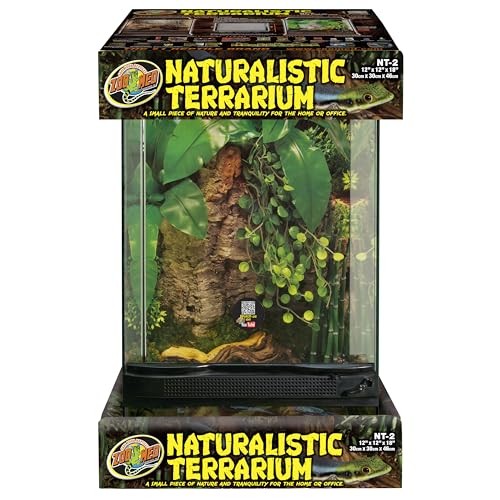
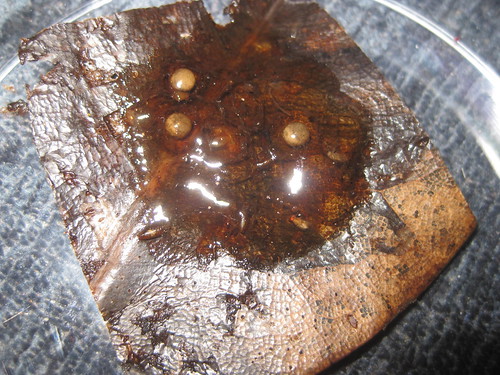

 Camo Samsung Galaxy Phone Caseson 11/21/2014
Camo Samsung Galaxy Phone Caseson 11/21/2014
 1957 Chevy Bel Air. My dream caron 10/15/2014
1957 Chevy Bel Air. My dream caron 10/15/2014
 Gift for Seniors....Things With Big Numbers and Letterson 05/09/2013
Gift for Seniors....Things With Big Numbers and Letterson 05/09/2013
 Puck Magazine, Very Collectible For a Number of Reasonson 05/06/2013
Puck Magazine, Very Collectible For a Number of Reasonson 05/06/2013

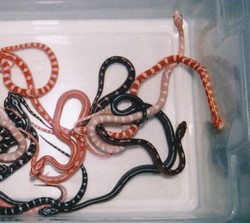
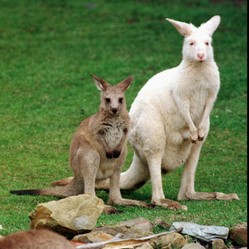
Comments
Poison dart frogs are fascinating creatures. I have read about them as being among best parents in amphibian world, but didn't know they are so easy (well, relatively) to bred in captivity. Thanks for the colorful tour. I enjoyed every single step:)